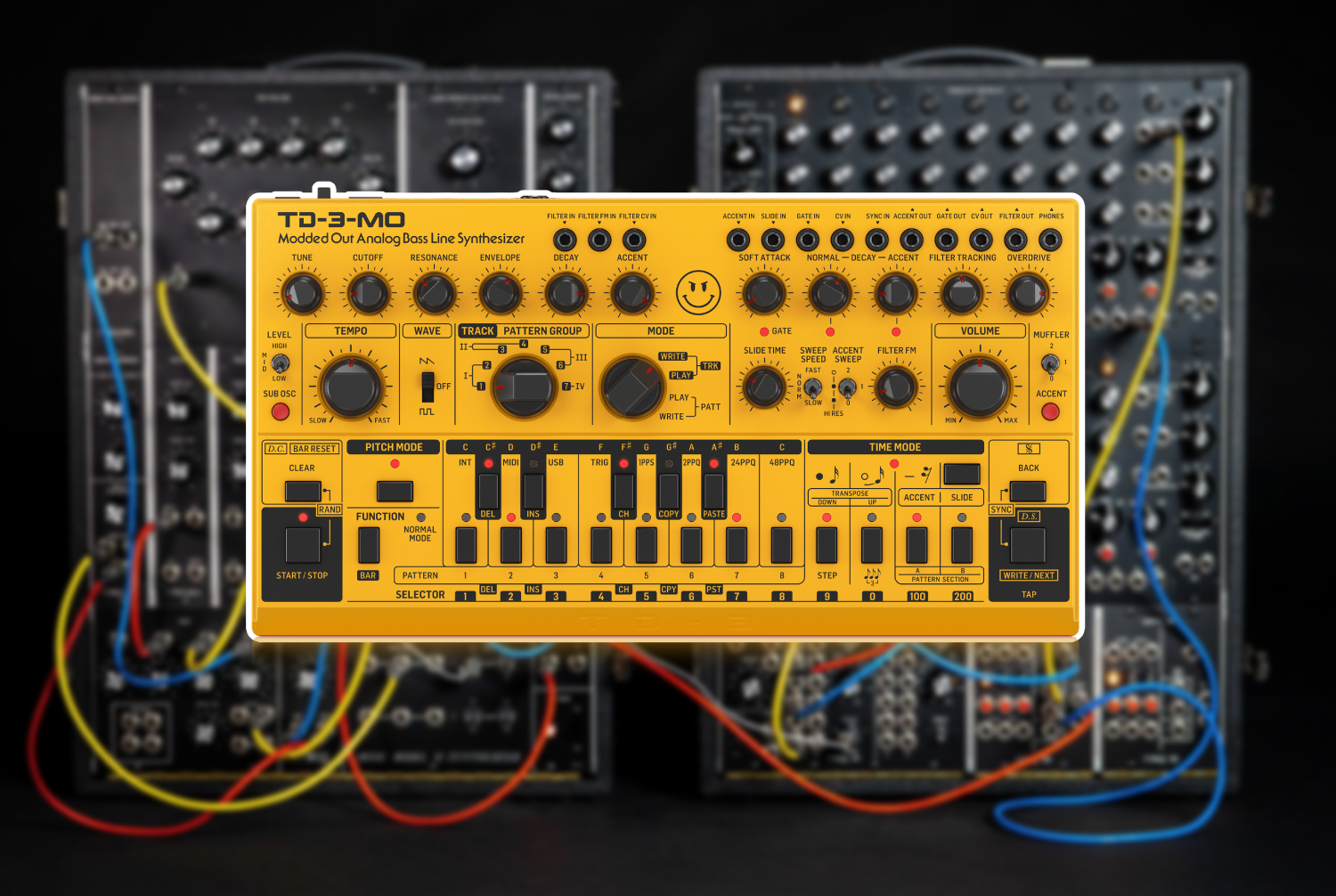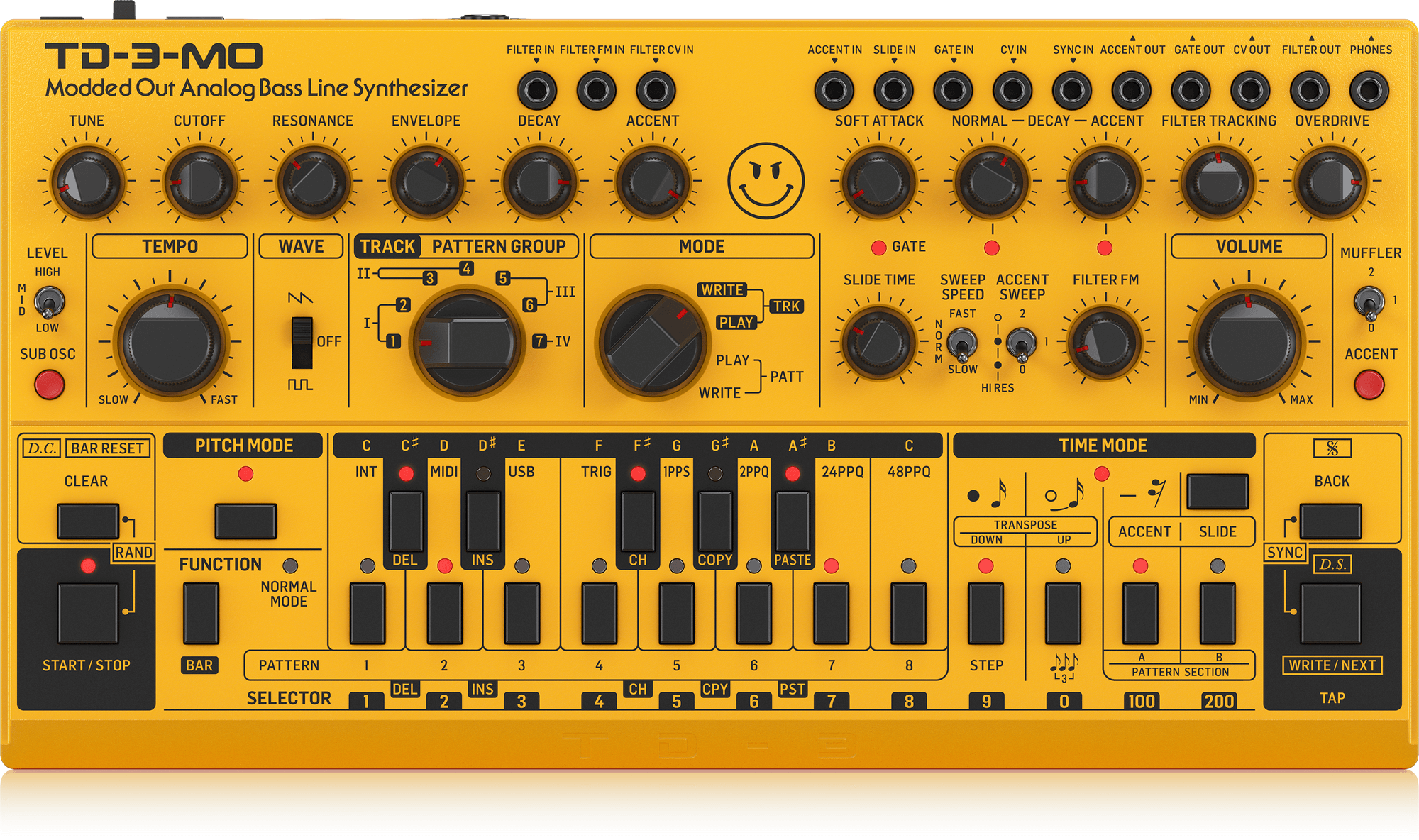Test: Behringer TD-3-MO - What can the Acid clone do?

These include extended filter functions including FM, a sub-oscillator, overdrive and customizable accent decay, which help the small cult synthesizer to produce more varied sounds. Despite the many new functions, the recommended retail price is just 50 Euro higher than for the unmodified version; the street price is currently about 100 Euro different from the TD-3, which is now available new for under 100 Euro in some cases.
No battery operation
The TD-3-MO sits in the same somewhat clunky-looking case made of cheap plastic as the TD-3 and weighs less than 800 grams, so the whole thing looks toy-like when you unpack it. This impression quickly fades, however, as soon as you have connected the small silver box and fired up the first bass lines - more about that later.
The controllers are also made of simple plastic and are not bolted to the housing, but here you also have to keep the low price in mind. Unfortunately, even with the modified version, unlike the original, battery operation is not possible to weigh the device down a bit and be able to operate current-dependent.
USB, MIDI, editor
USB and MIDI bring the TD-3-MO into the modern era in terms of connectivity. The TD-3-MO receives MIDI signals by means of the classic MIDI input and can, therefore, be played like a normal synthesizer or synchronized to the MIDI clock independently of the internal sequencer. The second MIDI jack sends the MIDI signals of the sequencer back out or loops incoming signals through. As a novelty of the MO version, the filter can be controlled via MIDI-CC and can thus automate filter runs in your DAW!
The USB port can also serve as a MIDI interface, but unlike on Roland‘s own replica TB-03 from the Boutique series, audio signals are not transmitted this way.

Software tool
Via the USB port, the TD-3 also communicates with Behringer‘s free Synthtribe software, which, in addition to system settings, allows you to edit sequences in a clearly arranged piano roll. Since the less than easy to program sequencer from the TB-303 was transferred over unchanged to the TD-3-MO, this additional option is especially helpful for 303 beginners.
Additional CV connections
The analog connections of the TB-303 are also found on the TD-3-MO, but have been moved to the top side. The CV/Gate outputs allow controlling other analog gear including a modular system with the built-in sequencer. The MO version has an additional CV output for the programmable Accent, which can be routed to the VCA or filter input of an external analog sound generator to emphasize individual steps, for example. Also new are the inputs for CV and Gate for controlling the TD-3-MO with other equipment and replacing the somewhat complicated sequencer with a classic and easy-to-use analog sequencer. Fittingly, there are plenty of additional CV modulation inputs for Accent, Slide, Filter Frequency and Filter FM. SYNC In provides synchronization of the internal sequencer to an analog clock.

Filter input
If you connect an external audio signal to the FILTER-IN jack, it will be looped into the sound generation of the TD-3 and can then be processed with the filter and effects. Since the TD-3 has only one oscillator, looping in an additional oscillator module for wider detuned sounds, for example, would be interesting. At center position, the internal oscillator can also be faded out completely.
Sub-oscillator
The TD-3-MO has the classic seven controls of the TB-303 for Tune, Cutoff, Resonance, Envelope, Decay and Accent. The basis of the pure analog sound generation is an oscillator, which provides the sawtooth and square waveforms. In the MO version, a sub-oscillator for the deep bass foundation can be added at three volume levels. This provides a much richer sound and makes the TD-3 also a recommendation for other music styles than just Acid, Techno, and House because the raw analog bass provides a good base in the low frequency range.
Character filter
The oscillator signal enters the low-pass filter, whose frequency and resonance can be adjusted by way of two additional controls and whose characteristic sound with the concise whistling, chirping and screeching at high resonance is responsible for the success of the TB-303. The mini-envelope can be adjusted in Decay Time, as well as Modulation Strength. Finally, the last control determines how strongly an Accent programmed in the sequencer affects various parameters of the sound generators. Among other things, Accent shortens the Decay Time to a minimum for the 303-typical barking and snapping.
Advanced envelope
The modification also provides more flexibility for this important decay parameter, as two additional controls allow you to individually adjust the Decay Time for accented and non-accented notes. An LED indicates the current status of the envelope with changing brightness. And with Soft Attack you can soften the attack, that is, extend the settling time of the envelope for notes without accent.
It is astonishing what sonic effects these additional options, which at first seem unspectacular, can have - suddenly sequences are created that are not immediately recognized as typical 303.
Filter tracking and FM
And there are even more functions to spice up the relatively simple sound generation of the TB-303. With Filter FM you modulate the filter frequency with the outgoing audio signal, which provides additional harmonics. Filter Tracking makes the filter open wider on higher played notes, giving them more high frequencies like a real instrument, which can add liveliness to bass lines and make them more controllable in the mix. In addition, this way the filter can be played tonally at high resonance thanks to self-oscillation like a sine oscillator. The actual oscillator can be switched off completely for this purpose. Alternatively, you can add the sub-oscillator and get sounds that you would not expect at all from a TB-303.
Saturation effect
The Muffler effect, which can be switched on in two stages, also expands the sonic potential of the TD-3-MO. This increases the volume before the VCA, so the amplifier stage is driven hotter. This creates a saturation effect that is especially audible at high resonance values. High frequency peaks, which can make the ears bleed, are lowered and the TD-3 sounds less sharp.
TB-303 sequencer
The sequencer and its controls are identical to the unmodified TD-3 or the original TB-303. This special and, at first glance, not very intuitive sequencer is at least as important a part of the popular 303 sequences as the sound generation and has a significant share in their distinctive, always pleasantly groovy and lively basslines - although, or just because, you rarely really know how it will sound in the end. A random function directly accessible via keystroke provides random patterns if required.
Slides and accents
Above all, the mix of slides and accents provides the incomparable groove that is responsible for the success of the TB-303. And in this area, the TD-3-MO also has exciting new features to offer to make the sequences more flexible. A set accent basically affects not only the Decay Time, but also the Resonance. With the TD-3-MOD, Accent Sweep lets you either add to this effect or turn it off. Also new are the adjustable Slide Time and Sweep Speed. This allows you to adjust the speed at which the pitch slides from one note to the next for steps with a set slide. Sweep Speed works relative to the length and the speed.
Built-in distortion
Behringer has also given the MO version an analog distortion at the end of the signal chain, which is based on the popular DS-1 Distortion foot pedal from Boss. The amount of distortion and the volume of the effect can be adjusted. Behind the Tone control hides a 1 knob equalizer: Turning it to the left makes the sound muddier and richer; turning it to the right cuts the bass in favor of the treble and allows the TD-3 to come through better in full mixes
Order now: Behringer TD-3-MOD
Want more? Get more!



Subscribe to the digital edition of BEAT Magazine via Plugins-Samples.com and get more gear, in-depth workshops, reviews and 11 GB exclusive plugins and new sounds with every monthly issue!
Subscribe to Beat Magazine for only 4.99€ per month
